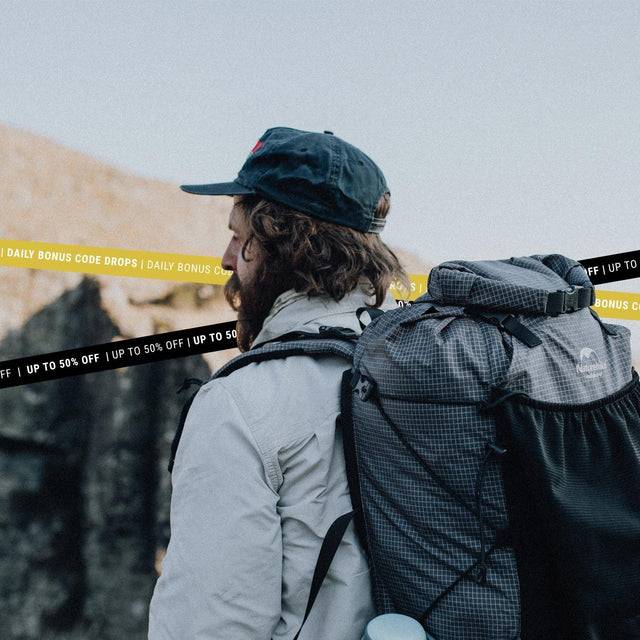Outdoor Kitchen Gear: Essential Equipment for SA Adventures
Preparing for a camping trip can be pretty stressful. Have you packed the right gear? Do you have all the essentials? Do you have a first aid kit in case of emergencies? Another aspect of camping that is easy to overlook is meal prep and the necessary outdoor kitchen gear needed.
The right outdoor kitchen gear makes meal prepping for the wilderness not only possible but enjoyable. Without proper cookware, stoves, and camp kitchen essentials, even the best meal plan falls apart on the trail. Naturehike doesn't do dry and dull, so we have provided this guide on what outdoor kitchen gear you need, along with meal prepping tips for any camping and hiking trip.
Essential Outdoor Kitchen Gear for South African Trails
The perfect outdoor cooking experience begins with selecting the right camp kitchen essentials. From the arid Karoo to the lush Garden Route, lightweight and durable cooking utensils designed for outdoor use are non-negotiable when backpacking through South Africa's diverse landscapes.
Backpacking Cooking Gear Checklist:
-
Portable stove (gas or multi-fuel power burner options)
-
Compact cookware (preferably nesting pots and pans)
-
Collapsible silicone bowls and cups
-
Foldable cooking utensils that suit various meal preparations
-
Multipurpose knife
-
Lightweight cutting board with flat, durable surface
We suggest choosing cooking gear with heat-resistant handles, scratch-resistant surfaces, and, most importantly, easy-to-clean surfaces that can withstand the rigours of outdoor adventures.
Creating Your Camp Kitchen
Transforming a campsite into a functional cooking area is no joke and requires thoughtful organisation. Naturehike's Camp Kitchen collection makes this process effortless, even on multi-day hikes on trails like the Otter Trail or Whale Trail. With the right outdoor kitchen cooking accessories, you can create delicious meals that enhance the ambience of your wilderness experience.
Meal Planning for South African Backpacking Adventures
Successful outdoor cooking starts before you leave home. Create a meal plan that accounts for:
-
Weight considerations: Aim for 400-500 calories per 100 grams of food
-
Water availability: Plan meals requiring less water in drier regions
-
Local ingredients: Incorporate easily found South African staples
-
Climate factors: Different dishes for coastal vs. highveld conditions
Pair a compact coffee maker with quick-cooking oatmeal for a satisfying start to your day. You won't need the wine cooler or refrigerator that you would stock in your house.
Lunch might include wraps with preserved meats stored in lightweight containers. Easy-to-cook meals on your camp stove should be your go-to in the outdoors.
Outdoor Cooking Techniques for the South African Wilderness
Master these cooking methods to elevate your wilderness dining experience:
One-Pot Cooking: Simplify cleanup while creating flavorful dishes using quality cookware by layering ingredients strategically. Proteins first, then vegetables, and finally quick-cooking starches.
Efficient Fuel Use: Modern stoves and wind shields maximise heat efficiency while minimising fuel consumption.
Conservation Cooking: In water-scarce areas, use stackable cookware systems to minimise water usage—one pot for cooking that becomes your eating vessel eliminates extra cleaning.
Good Ol' Braai: For our Saffas, compact braai equipment lets you enjoy traditional cooking methods even in remote locations, when regulations permit.
Outdoor Kitchen Accessories Worth Their Weight
While minimalism rules backpacking, certain essential accessories truly enhance your outdoor cooking experience:
-
Titanium Cookware: Ultra-lightweight premium pieces that won't weigh down your pack
-
Dedicated Coffee Gear: For when instant just won't cut it after a challenging hike
-
Compact Coolers: Essential for keeping ingredients fresh and beverages cool on multi-day trips
-
Space-Saving Utensils: Multifunctional tools that reduce weight while maximising utility
Adapting Your Outdoor Kitchen for Various South African Environments
South Africa's diverse ecosystems demand adaptable cooking strategies:
Coastal Camping: In areas like the Wild Coast, wind shields help protect your cooking area from sand and salt spray. Select cookware that resists corrosion from marine environments, and consider bringing a portable grill for preparing freshly caught seafood.
Mountain Expeditions: At higher elevations in the Drakensberg or Cederberg, water boils at lower temperatures. Extend cooking times accordingly and choose stoves that maintain consistent performance even at altitude. Titanium cookware heats quickly, saving precious fuel in cold mountain conditions.
Bushveld Adventures: Proper food storage becomes essential when exploring Kruger or Pilanesberg. Cooler boxes and sealed containers provide wildlife-aware food storage, keeping your provisions secure and preventing unwanted dinner guests from visiting your camp. Having wine and drinks securely stored is especially important in these environments.
The Joy of Outdoor Meal Prep
Creating memorable outdoor cooking experiences is about connecting with South Africa's remarkable landscapes through all your senses. With the right equipment and techniques, meal preparation becomes less of a chore and a fun but integral part of your adventure.
For more outdoor hacks and specialised gear for South African adventures, explore Naturehike's range.



0 Comments
There are no comments for this article. Be the first one to leave a message!